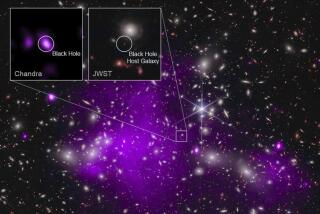With Hubble’s Help, Researchers Put Universe’s Age at 14 Billion
- Share via
By examining the feeble, burned-out husks of the oldest stars in our galaxy with the Hubble Space Telescope, astronomers have shown that the universe is at least 14 billion years old.
Scientists described Wednesday’s news as “like suddenly opening a drawer and finding your birth certificate,” said Bruce Margon, an associate director of the Space Telescope Science Institute, the organization that operates Hubble.
The new birthday lies within the best estimated range of the age of the universe to date: 13 billion to 14 billion years. The independent confirmation suggests that, after decades of sometimes frustrating work, astronomers using entirely different methods finally are nearing the correct answer. Such unanimity on a basic fact is crucial in answering more sophisticated questions about how the universe behaves.
“It makes everybody feel happier that we each individually know what we are talking about,” said Brad Hansen, a postdoctoral astronomy researcher at UCLA who helped create the new measurement with Harvey Richer, an astronomer at the University of British Columbia.
Though it is such a basic measurement and fundamental to understanding how the universe was created and evolved, determining the age of the universe has proved excruciatingly difficult. Until a few years ago, estimates of the age ranged from a whopping 20 billion years to a mere 8 billion--an age that suggested the unsettling notion that the universe was younger than the stars within it.
The new measurement was made by looking at the charred remnants of white dwarfs, massive stars that burned out long ago. Because these stars cool at a constant rate, they are sometimes called “clockwork stars.” Scientists can estimate the age of the universe by measuring the color and brightness of the remains of these white dwarfs and then calculating how long it had taken for a star to cool to its current state.
It is the equivalent of estimating how long ago a campfire was burning by measuring the temperature of the smoldering coals it left behind. Because these coals were billions of years old, they were very faint. For years, astronomers did not even bother trying to look for them, Hansen said. “People thought they were too faint, that they weren’t observable.”
But modeling work by Hansen showed that the old dead stars were not merely “black bodies,” but gave off visible light because of the complexities of their atmospheres.
Given this information, Richer and his team decided to use the Hubble telescope to find the ancient star remnants. Because they are so faint, detecting them required an exposure of eight days.
The stars studied were in the densely packed globular star cluster M4, which lies just 7,000 light years from Earth.
The dead stars are so faint, they are less than one-billionth the brightness of stars visible to the naked eye. The astronomers focused on globular star clusters because they are among the oldest objects in the universe.
The stars that were studied were thought to have formed about 1 billion years after the Big Bang, according to leading theories. That means that, if the stars are approximately 13 billion years old, the universe is at least 14 billion years old.
If future work shows that more time passed between the Big Bang and the formation of the first globular star clusters, it would mean the universe is older than 14 billion years. But astronomers said it was unlikely anything would change the estimation that the universe is at least 14 billion years old.
Previous work by Wendy L. Freedman of the Carnegie Observatories in Pasadena had estimated the age of the universe by trying to measure how quickly it is expanding. The astronomers did this by measuring how fast other galaxies were moving away and how far away they were.
This expansion rate is known as the Hubble constant, for Edwin Hubble, a California astronomer who in 1929 discovered that the galaxies were flying outward at speeds that increase as they get farther away. Precisely determining the expansion rate long has been one of the outstanding questions in cosmology.
In the late 1990s, Freedman used the Hubble telescope to measure the distances of stars of variable brightness, called Cepheids, to accurately determine the universe’s current rate of expansion. Some of the early results suggested that the universe was only 8 billion years old, younger than its stars.
The universe also threw a wrench in the works. Studies of distant, exploding supernovae showed that the universe was not expanding at a constant rate. Because the universe expanded more slowly in the past, then suddenly shifted into high gear, it was difficult to pinpoint its age.
Astronomers came up with a new notion--a mysterious force called dark energy that is speeding up the pace at which the universe expands.
Even though astronomers admit they have no idea what dark energy is or how it works, they added it to their estimates of the age of the universe. That boosted the age estimate from 8 billion or 9 billion years to the current 14 billion years, Freedman said.
The new measurement of aging stars is an entirely different method and does not rely on expansion rates or dark energy.
Freedman did not participate in the experiment announced Wednesday but was among the first to applaud the result.
“What’s pleasing about the whole field is that many different methods are all pointing in very similar directions,” she said.






